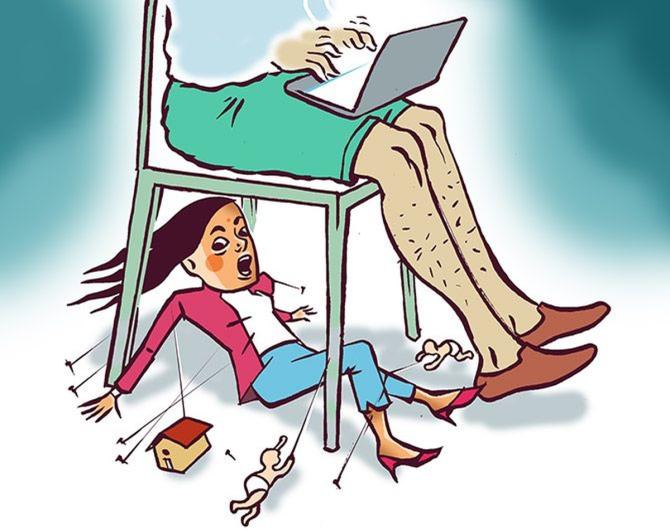Indian women have education, inspiration and perspiration -- but not enough employment, points out Mahesh Vyas.

The world celebrated International Women's Day on March 8.
This, according to the official Web site, is a day to celebrate social, economic, cultural and political achievements of women.
It is perhaps also a time to take stock of where India stands today and where it is likely headed in terms of achievements of women.
Over eight per cent of directors on boards of listed companies were women in 2019-2020.
More impressively, 64 per cent of listed companies have at least one woman director. Legislation has helped.
Only about 3 per cent of unlisted companies' directors are women and only 11 per cent of unlisted companies have at least one woman director.
The Companies Act made it mandatory in 2014 for every listed and large unlisted company to have a woman on its board of directors.
But, it is not just legislation. An estimated 1.7 per cent of CEOs of companies in India are women.
These numbers are small but they are important. Women like Indra Nooyi of PepsiCo and Kiran Mazumdar-Shaw of Biocon are iconic and hugely inspiring.
Women have been great thought leaders in India. Aruna Roy, Arundhati Roy, Mira Nair, Aparna Sen, Deepa Mehta, Romila Thapar, Ela Bhatt, earlier Sarojini Naidu, Amrita Pritam and Mahasweta Devi make an impressive, though random, list of inspiring women. Of course, there are many more.
Over 14 per cent of members of Parliament elected in the 2019 Lok Sabha polls were women.
This proportion was over 11 per cent in the 2014 elections, nearly 11 per cent in 2009 and 8 per cent in 2004.
The Women's Reservation Bill proposed in 2008 that sought to reserve 33 per cent of parliamentary seats for women was never passed. But, women continue to make progress even without legislation.
One in five of all IAS officers is a woman. It could be better but it is better than the representation of women in the judiciary.
One in nine high court judges and only one in 30 Supreme Court judges is a woman.
Numbers matter but influence is of equal importance. Women political leaders in India have been very influential.
Indira Gandhi, Sonia Gandhi, Mamata Banerjee and Jayalalithaa have been or continue to be big mass influencers.
It is fair to assume that women in India will continue to attain greater positions of power and influence in the coming years.
Rising education and inspiration from torch-bearers will increase the number and proportion of women CEOs, judges, administrators and political and thought leaders.
The battle on education of women in India was won a decade ago.
Fifty per cent of all fresh graduates were women between 2011-12 and 2015-16.
In 2018-2019, 53 per cent of all fresh graduates were women. The proportion of women in the total population is less than half. Yet, more than half the fresh graduates are women.
In spite of this education and the scores of inspiring success stories of women in the corporate and non-corporate world, the average Indian woman is woefully far from being an employed woman. She works hard, but is not employed.
The challenge, it appears, is that Indian society is biased against women working outside their homes.
It is in the urban regions where the true test for women working outside their homes lies.
According to the official Periodic Labour Force Survey, in 2018-2019, while 73.7 per cent of urban men participated in the labour markets, only 20.4 per cent of urban women did so.
In spite of this very low participation, women faced a higher unemployment rate of 9.8 per cent in urban India, compared to the 7 per cent unemployment rate faced by men.
Why should equally educated women face a higher unemployment rate than men even though very few women seek employment?
Only 18.4 per cent of urban women aged 15 or more were employed in 2018-19, according to PLFS. But, 68.6 per cent of urban men in the same age bracket were employed. This is as disturbing as it is intriguing.
CMIE's Consumer Pyramids Household Survey, which has a far more stringent definition of employment, depicts a picture that is much grimmer.
Only 8.4 per cent of urban women of 15 years or more were employed in 2018-2019.
This fell to 7.3 per cent in 2019-2020 and it is likely to have fallen to less than 6 per cent in 2020-2021.
In February 2021, the urban female employment rate touched 5.4 per cent. There is almost no recovery from the pandemic-hit low of 5 per cent in April 2020.
Indian women work a lot. But, their work is predominantly at home, in service of other members of their household.
Their participation in the labour markets outside their houses in urban India is very low in spite of their superior education.
There are only three cases under which this can happen. Either Indian women are not willing to go out to work or they are not allowed to go out to work or people are not willing to give them work in spite of their education.
The second and third cases reflect bias in society and possibly, they cause the first case.
Indian women have education, inspiration and perspiration -- but not enough employment.
Mahesh Vyas is MD & CEO, CMIE Pvt Ltd.
Feature Presentation: Rajesh Alva/Rediff.com










